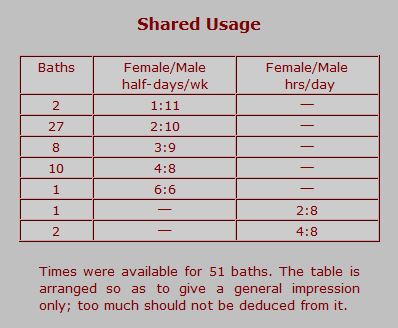This is a single frame, printer-friendly page taken from Malcolm Shifrin's website
Victorian Turkish Baths: their origin, development, and gradual decline
Visit the original page to see it in its context and with any included images or notes
4. Availability of the baths to women
Women's areas were generally smaller than those provided for men, or else they were similar to the men's second class baths, as in Cookridge Street, Leeds.19
Nevill's flagship baths in Northumberland Avenue were spacious and lavishly fitted and furnished and, as Robert Owen Allsop wrote,
They…comprise both ladies' and gentlemen's baths, though, as at the old Pompeian Balneć, the former set are ungallantly cramped into a very small space.
And it seems typically Victorian that the Keighley Board of Health decided to build separate first and second class baths—for men and women to use on different days—instead of one bath for men, and a second for women, both of which could be used every day.
In Turkish baths open to the general public, women almost invariably seem to be at a disadvantage compared with men. Where facilities were shared, only one, Richardshaw Lane in Leeds, allowed women equal access.
In over half of the fifty establishments for which occasional figures are available, women were limited to the equivalent of one day per week. The remaining baths allocated either one-and-a-half or two days, in roughly equal proportion.
In 1858, a letter to the editor of a local paper about the Leeds Road establishment in Bradford read:
I know it is not orthodox for ladies to be newspaper correspondents. This however is a subject in which our sex has equal interest with the gentlemen…The ladies ought to have at least three nights in the week. On the two nights of the week the rooms are inconveniently crowded, and even sometimes during the afternoons.
Such complaints were not–and still are not–unusual. As recently as 1993, The Journal reported, under the heading 'Bath time battle of the sexes', that,
Newcastle-upon-Tyne women have spent a year campaigning for equal access times which have always favoured the men (3 days to 2) since the baths opened in 1928.
Women were told their days were not sufficiently patronised. One company chairman, apologising for the provision of just one day per week, said they had found wherever they had enquired,
that the ladies had not taken advantage of those baths, and, however much they might desire to be gallant to them, they wanted to see their funds first.
James Forder Nevill put it more bluntly, saying that they tried to open a ladies bath in Paddington but 'Paddington women won't take Turkish baths.'
Undoubtedly, Josephine Butler's supporter, Dr Baxter Langley, was closer to the mark when he argued that,
Turkish Baths at present exclude women by their high prices, and in any public arrangements the female sex should be specially catered for.
But providing publicly funded Turkish baths was thought to be of doubtful legality at that time, and none was built in London till after Victoria's reign.
This page revised and reformatted 29 October 2018
The original page includes one or more
enlargeable thumbnail images.
Any enlarged images, listed and linked below, can also be printed.
Northumberland Avenue plans
Advertisement Cardiff Ladies Turkish Baths

Victorian Turkish Baths: their origin, development, and gradual decline



Comments and queries are most welcome and can be sent to:
malcolm@victorianturkishbath.org
The right of Malcolm Shifrin to be identified as the author of this work
has been asserted by him
in accordance with the Copyright, Designs and Patents Act 1988
© Malcolm Shifrin, 1991-2023
